Charging Methods
The development of battery technology has been advancing new electronics, electric cars, and renewable energy. Knowing how different battery charging methods work is important for getting the best performance and longest life from batteries. This article looks at various charging methods, like Constant Voltage (CV) and Constant Current (CC), their combinations, and new methods like Constant Power (CP) charging. It also covers advanced techniques like Pulse Charging and the innovative IUI Charging method that are designed for specific types of batteries. Each method has its own advantages and is best for certain uses, showing the detailed needs of modern battery technology. This article not only explains how these methods work but also shows how they are used in today’s tech-driven world, and sets the stage for a detailed look at each charging method, how they work, and the technological advances that keep changing the field of battery charging.
Catalog
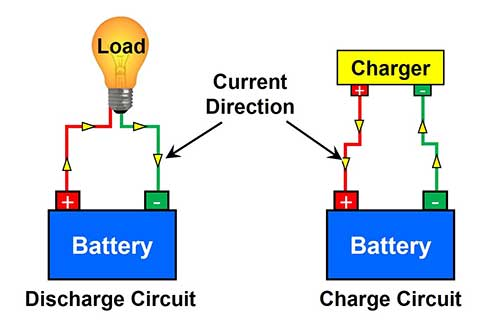
Figure 1: Battery Charging Works
Constant Voltage Charging
Constant Voltage (CV) charging is a method where the voltage applied to a battery remains fixed throughout the charging process. This differs from Constant Current (CC) charging, where the current is kept constant while the voltage varies. In CV charging, the battery is charged until it reaches a predetermined voltage level. At this point, the voltage is maintained, and the current decreases as the battery nears full charge. This method ensures the voltage stays within a safe range, preventing overcharging and potential battery damage.
This charging method required in the final stage of charging lithium-ion batteries. It provides precise voltage control, ensuring each cell in the battery pack reaches the optimal charge level without exceeding the maximum voltage limit that can harm the battery’s chemistry and lifespan.
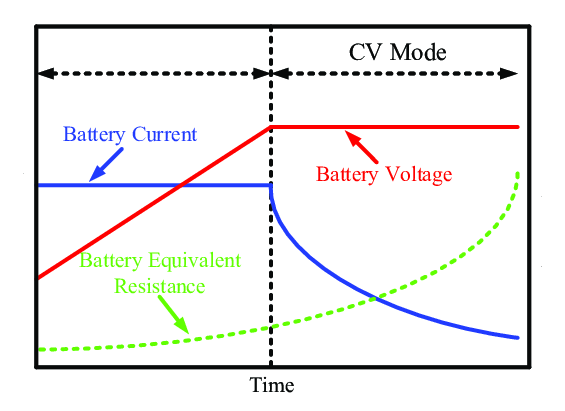
Figure 2: Graph of the Constant Voltage (CV) Charging
How Constant Voltage (CV) Charging Works?
Here's a detailed breakdown of the CV charging phase:
During the Constant Current (CC) phase, the battery is charged until it hits a specific voltage threshold, close to its maximum capacity (around 4.2 volts per cell for most lithium-ion batteries).
Once this threshold is met, the charging circuit transitions from CC to CV mode. The charger then applies a constant voltage to the battery.
At the start of the CV phase, the charging current is high. As the cell voltage nears the charger voltage, the current decreases gradually. This happens because the potential difference between the charger and the battery reduces, naturally limiting the current flow according to Ohm's Law.
As the battery continues to charge, less current is required to maintain the voltage. This decreasing current indicates that the battery is nearing its full charge capacity.
The charging process ends when the current drops to a small fraction of the initial charge rate, often about 10% of the starting current. This drop in current signals that the battery is fully charged.
Constant Current Charging
Constant current (CC) charging is a battery charging method where a fixed current is supplied to the battery until it reaches a specific voltage level. Unlike constant voltage (CV) charging, where the voltage remains steady and the current decreases as the battery charges, CC charging maintains a steady current throughout the charging process. This current is specified by the battery manufacturer or determined based on the battery's characteristics. As the constant current flows into the battery, its voltage increases. Once the battery reaches its designated voltage threshold, the charging method may switch to constant voltage charging to complete the cycle, ensuring the battery is fully charged without overcharging.
The basic principle of CC charging involves keeping the current flowing into the battery constant throughout the charging phase. This is achieved using current regulation circuits or devices that monitor and adjust the current output to match the desired level. This method ensures efficient energy transfer and minimizes stress on the battery cells. Constant current charging is widely used in various applications, including consumer electronics, electric vehicles, and industrial equipment, due to its simplicity and effectiveness in charging batteries safely and reliably.

Figure 3: Graph of the Constant Current Charging
Emerging Technologies in Battery Constant Current (CC) Charging
Advancements in this field are driven by the need for more efficient, faster, and safer charging solutions, focusing on innovative materials, battery management systems, and smart algorithms. Below is an engaging overview of these emerging technologies:
|
Category |
Technology |
Description |
Benefits |
|
Electrode Materials |
Silicon Anodes |
Silicon can store ten times more lithium
ions than graphite, leading to higher energy densities and quicker charging. |
Higher energy density, faster charging |
|
Lithium Metal Anodes |
Lithium metal offers higher capacity but
poses risks of short circuits from dendrites. Solutions include advanced
electrolytes and solid-state designs. |
Higher capacity, enhanced safety |
|
|
Battery Management Systems (BMS) |
Adaptive CC Charging |
Monitors each cell’s charge, temperature,
and health, adjusting the current in real-time using machine learning and
advanced algorithms. |
Optimized efficiency, prolonged battery
life |
|
Wireless CC Charging |
Resonant Inductive Coupling &
Magnetic Resonance |
Techniques that allow efficient energy
transfer over short distances without physical connectors, now being scaled
for larger applications like EVs. |
Seamless, rapid energy replenishment for
EVs |
|
Nanotechnology |
Carbon Nanotubes & Graphene |
Nanostructured materials with exceptional
electrical conductivity and surface area, incorporated into battery
electrodes to reduce charging times and improve durability. |
Faster charging, improved battery
durability |
|
Hybrid Supercapacitor-Battery Systems |
Combining supercapacitors for rapid
charging during the CC phase with batteries for high energy storage. |
High power and energy density, rapid
charging capabilities |
|
|
Software and Control |
AI & Predictive Modeling |
Uses vast data analysis to determine
optimal charging parameters, learning from previous cycles to refine charging
profiles and prevent overcharging and overheating. |
Faster, safer, and more efficient
charging |
|
IoT Integration |
IoT-enabled Chargers & Batteries |
Enables communication between chargers,
batteries, and centralized systems to optimize charging schedules and monitor
battery health in real-time. |
Cost savings, grid load balancing,
real-time monitoring for battery longevity and reliability |
|
Regulatory and Standardization |
Regulatory and Standardization Efforts |
Establishes guidelines for safe and
efficient implementation of new CC charging technologies, ensuring
compatibility and safety across different applications and manufacturers. |
Facilitates market integration, ensures
safety and compatibility |
Hybrid Constant Voltage/Constant Current (CVCC) Charging
Hybrid CVCC (Constant Voltage, Constant Current) charging is a modern way to charge batteries. It uses both constant voltage and constant current techniques to make the charging process better. The main goal of hybrid CVCC charging is to make batteries last longer, charge safely, and work efficiently. This method is useful for electric cars, consumer gadgets, and renewable energy storage.
Traditional charging uses either constant voltage or constant current the whole time. In constant current (CC) charging, the battery gets a steady current until it hits a certain voltage. In constant voltage (CV) charging, the battery gets a steady voltage while the current slowly decreases as the battery fills up. Hybrid CVCC charging combines these two ways to fix their problems and use their strengths.
The purpose of hybrid CVCC charging is threefold. First, it aims to shorten charging time while safely filling the battery to its maximum capacity. This is very important for things like electric cars that need quick charging to reduce downtime. Second, it helps the battery last longer by avoiding overcharging and overheating, common issues with traditional charging. By carefully controlling the voltage and current, hybrid CVCC charging reduces wear on the battery cells. Lastly, this method boosts energy efficiency by making sure the power delivered to the battery is optimized, reducing energy loss and making better use of available power.

Figure 4: Graph of the CVCC Charging
How Hybrid Constant Voltage/Constant Current (CVCC) Charging Works?
Initial Phase: High Current
The hybrid constant voltage/constant current (CVCC) charging method starts by charging the battery with a high current. During this phase, the charging system delivers a consistent, high current to the battery regardless of its voltage. This approach rapidly charges the battery to a level of its capacity within a short time. The high current phase is require for quickly bringing the battery to a usable state.
As the battery absorbs the incoming current, its voltage rises. The charging system monitors the battery's voltage and current to ensure safety limits are not exceeded. This phase is effective for batteries capable of handling high current inputs without damage or excessive heat. The duration of this phase varies depending on the battery type and capacity but aims to quickly charge the battery to a predetermined voltage level.
Transition Phase: Gradual Reduction in Current
As the battery's voltage nears the target, the charging system transitions to the second phase, where the current reduces. Once the battery reaches a specific voltage threshold, the system decreases the current while keeping the voltage constant. This helps prevent overcharging and reduces stress on the battery cells.
The transition phase requires a balance between maintaining constant voltage and ensuring the current stays within safe levels. The system uses algorithms and feedback mechanisms to monitor the battery's state and adjust the current. The goal is to bring the battery closer to full capacity while minimizing overcharging risks. This phase fine-tunes the energy input to ensure optimal charging efficiency and safety.
Final Phase: Reaching the Voltage Target
In the final phase, the charging system maintains a constant voltage while allowing the current to taper off to zero. As the battery nears full charge, the current need to maintain the constant voltage decreases. This phase ensures the battery is fully charged without overcharging or causing damage.
Maintaining a constant voltage in this phase allows the battery to complete its charge cycle safely and efficiently. The charging system continues to monitor the battery's voltage and current, making real-time adjustments to keep the voltage stable. Once the current reaches a minimal level or zero, the charging process is complete, and the battery is fully charged.
This final phase maximizes the battery's charge capacity and readiness for use. By controlling voltage and current throughout the process, the hybrid CVCC method provides a reliable and efficient way to charge batteries, enhancing performance and extending lifespan.
Constant Power Charging
Constant power charging uses a dynamic approach. It starts with a high current when the battery voltage is low and reduces the current as the voltage increases. This method adapts power delivery based on the battery's state, maximizing charging efficiency and reducing battery stress.
Constant power charging is a technique used mainly for charging batteries where the input power is kept constant throughout the charging cycle. Power, defined as the rate of energy transfer, is calculated by multiplying voltage (V) and current (I) (P = V x I) . In this method, as the battery's voltage increases, the current is adjusted to ensure the power remains constant. This approach optimizes the initial phases when the battery can safely accept higher energy transfer rates without overheating or stress.
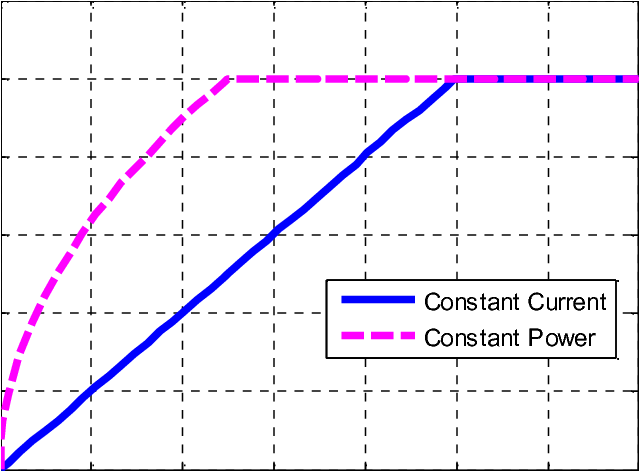
Figure 5: Graph of the Constant Current vs. Constant Power Charging
How It Differs from Other Charging Methods?
Constant power charging is different from the more common methods like constant current (CC) and constant voltage (CV) charging. In constant current charging, the charger gives a steady current to the battery even as the voltage changes. This works well at first but gets less efficient as the battery gets fuller, can cause too much voltage and stress the battery.
Constant voltage charging sets the charger to a fixed voltage, and the current decreases as the battery fills up. This helps avoid overcharging and ensures the battery charges fully without going over the voltage limit.
Constant power charging tries to combine the good points of both methods. It adjusts both current and voltage to keep the power level steady. This can charge the battery quickly at first, like constant current, and then slow down as the battery voltage rises, like constant voltage. This method helps manage stress on the battery, making it a good choice for things that need fast charging and long battery life, like electric cars and high-capacity devices.
Constant Power Constant Voltage (CPCV) Charging
Constant Power Constant Voltage (CPCV) combines two methods: constant voltage (CV) and constant power (CP). In CV mode, the charger keeps the voltage steady to avoid overcharging the battery, when it's almost full. In CP mode, used at the start, the charger gives power at a constant rate for fast charging, managing the battery's heat and stress.
This method begins with constant power to rapidly deliver energy at high currents when the battery voltage is low. As the battery nears full charge, it shifts to constant voltage charging to refine the process and prevent overvoltage. This strategy is effective for rapidly charging batteries up to a substantial capacity before optimizing the final charging stages, ensuring efficiency and safety.
CPCV works with different types of batteries, like lithium-ion, that need careful charging. The system switches between CP and CV based on the battery’s charge level and other factors.

Figure 6: Graph of the Constant Power Constant Voltage (CPCV) Charging
Types of Batteries and Devices that Benefit Most from CPCV Charging
Batteries Best Suited for CPCV Charging
CPCV (Constant Power Constant Voltage) charging is beneficial for lithium-ion (Li-ion) and lithium-polymer (LiPo) batteries. These battery types are common in modern high-tech devices. CPCV charging begins with a constant power phase, where the battery quickly absorbs a lot of energy without hitting high voltage levels too soon. Once the battery reaches a certain voltage, the charging shifts to a constant voltage phase, keeping the voltage stable to complete the charging process safely without stressing or overheating the battery.
Devices That Gain from CPCV Charging
• Smartphones and Tablets: These gadgets need fast and efficient charging to enhance battery life and performance.
• Laptops: Similar to smartphones, laptops benefit from quick yet safe charging, helps maintain battery health for prolonged use on battery power.
• Electric Vehicles (EVs): EVs have large battery packs that benefit from CPCV charging. The method quickly charges the battery to a high level before switching to constant voltage to safely finish the process.
• Power Tools: High-capacity batteries in power tools can be recharged swiftly and safely with CPCV, reducing downtime and ensuring the tools are ready for use.
Pulse Charging
Pulse charging is a method used to charge batteries by applying bursts of high current, followed by rest periods with no current or a brief discharge. Unlike traditional methods that use a constant stream of current, pulse charging involves cycles of charging and resting. This technique aims to replicate natural charging processes found in biological systems, optimizing the balance between energy input and the battery's chemical stability.
This method can be tailored for different battery types, such as lead-acid, nickel-cadmium (NiCd), nickel-metal hydride (NiMH), and lithium-ion batteries. Each type may require unique pulse configurations, including variations in pulse strength, duration, and rest periods.
Pulse charging one big benefit is that it reduces the formation of dendrites in lithium-ion batteries. Dendrites are needle-like structures that can form during charging and cause short circuits, reducing battery life and safety. The stop-and-start nature of pulse charging helps control how lithium deposits on the electrodes, lowering the risk of dendrites forming.
Pulse charging can improve battery performance and lifespan by reducing heat generation during charging. This helps keep the battery at the right temperature, preserves its capacity and extends its life. This is important for high-capacity batteries in electric vehicles and portable electronic device.
Pulse charging can also speed up the charging process without damaging the battery. It allows for faster energy restoration compared to continuous current charging, and helpful for applications that need quick recharge times, like emergency power systems or during short automotive stops.

Figure 7: Pulse Charging of Lithium Ion Battery
How Pulse Charging Works?
Pulse charging is an advanced method for charging batteries that aims to improve the efficiency and lifespan of rechargeable batteries like nickel-cadmium (NiCd), nickel-metal hydride (NiMH), and lithium-ion (Li-ion) cells. Unlike traditional continuous direct current (DC) charging, pulse charging delivers charge in short, controlled bursts or pulses. This method optimizes the charging process and addresses common battery issues such as overheating and the "memory effect" in NiCd batteries.
Pulse charging works by intermittently applying a higher current to the battery for a brief period followed by a rest period with no current. These pulses reduce overall thermal stress on the battery by allowing heat to dissipate during the rest periods, minimizing temperature rise and potential damage.
Pulse chargers use two main types of pulses:
• Charge Pulses: High current pulses that rapidly charge the battery. The amplitude, duration, and frequency of these pulses vary depending on the battery type and condition.
• Discharge Pulses: Occasionally interspersed with charge pulses, these help destratify the battery electrolyte and reduce the memory effect in NiCd batteries.
The charger controls the duration of the charging pulses and the intervals between them using feedback mechanisms that monitor battery parameters such as voltage and temperature. This feedback allows the charger to adjust the charging process, enhancing the battery’s charge acceptance and overall health.
Trickle Charging
Trickle charging is a technique used to keep batteries fully charged while avoiding overcharging. It works by delivering a small, consistent flow of electricity to the battery, matching its natural self-discharge rate. This method is useful for devices that aren’t used frequently, ensuring they remain charged and ready without harming the battery’s health.
This process applies a minimal, continuous current, ideal for maintaining a battery’s charge over long periods. The slow charge rate keeps the battery healthy and ready to use, even when fully charged. While beneficial for standby batteries, it’s not recommended for NiMH and lithium-ion batteries, as they can be damaged by prolonged low-level charging.
The main goal of trickle charging is to keep a battery at optimal charge indefinitely. The trickle charging process involves carefully regulating the electrical current flowing into the battery. The charger first checks the battery’s voltage to decide how much current to provide. If the voltage is below the target, the charger supplies a higher current to recharge it. Once the target voltage is reached, the charger switches to a lower, steady current that matches the battery’s self-discharge rate. This approach keeps the battery fully charged without the risk of overcharging, extending its life and performance.
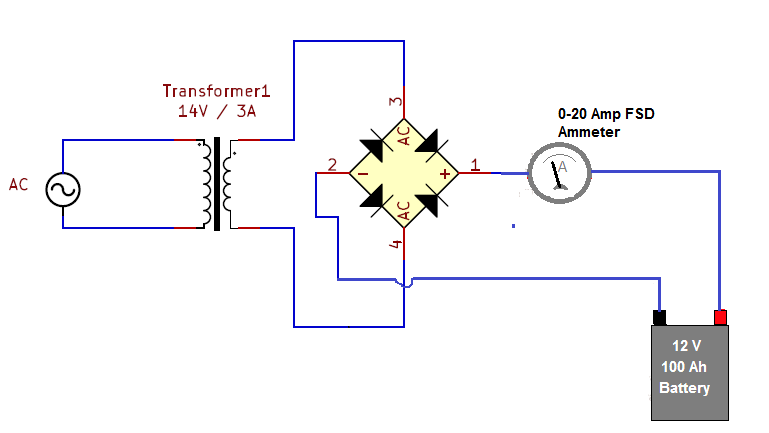
Figure 8: Trickle Battery Charging
Suitability for Different Types of Batteries and Applications
Lead-Acid Batteries: Both float and pulse charging are suitable. Float charging is often preferred for stationary uses like emergency systems.
Nickel-Cadmium Batteries: These batteries can use both pulse and float charging, beneficial when overcharging is a concern.
Lithium-Ion Batteries: These are not suited for trickle or float charging due to their sensitivity to overcharging. Pulse charging, with controlled bursts and appropriate circuitry, is better suited to protect and maintain lithium-ion batteries.
Multi-Stage Constant Current (MCC) Charging
Multi-Stage Constant Current (MCC) charging is an advanced technique for charging battery cells, especially lithium-ion and lead-acid batteries. This method involves distinct stages of constant current charging, each tailored to different phases of the battery's charge cycle. The main goal of MCC charging is to enhance battery health and longevity by adjusting the current delivered during various stages of the charging process.
In the first stage, a higher constant current is applied to rapidly charge the battery to a portion of its capacity. This phase, known as bulk charging, efficiently increases the battery’s charge level.
As the battery reaches certain voltage thresholds, the charging system shifts to stages with lower currents. These stages provide finer control, preventing overcharging and reducing stress on the battery cells. This careful modulation helps maintain the battery's lifespan and efficiency.
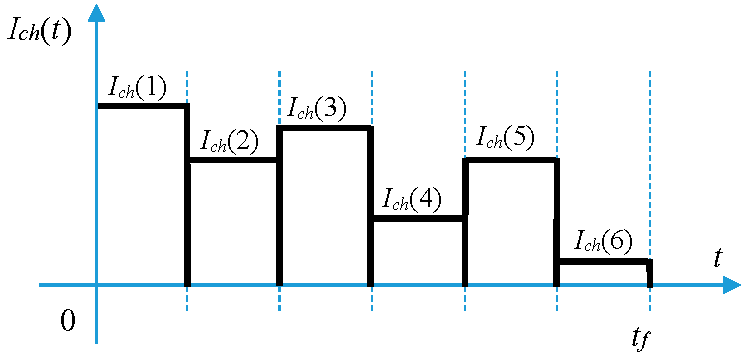
Figure 9: Graph of the Multi-Stage Constant Current (MCC) Charging
Advantages of MCC Charging
|
Aspect |
MCC Charging |
|
Battery
Health |
Minimizes stress during charging |
|
Current
Adjustment |
Adjusts based on battery's charge level |
|
Overheating
Prevention |
Reduces current as charge increases to
prevent overheating |
|
Battery
Longevity |
Enhances overall health and longevity |
|
Temperature
Management |
Keeps temperature within optimal ranges |
|
Voltage
Management |
Prevents excessive voltage stress |
|
Efficiency |
Charges quickly without sacrificing
safety |
|
Capacity
and Stability |
Maintains higher capacity and stability
over lifespan |
|
Application
Suitability |
Suitable for various applications
(electronics, vehicles) |
Taper Current Charging
Taper Current Charging, derived from the constant voltage method, reduces the charging current as the battery voltage rises. This simpler method requires careful monitoring to prevent overcharging, especially in sealed lead-acid batteries, to avoid degradation or failure.
As the battery charges, its internal resistance goes up and can cause higher temperatures and possible damage if the initial high charging current is kept the same. Reducing the current, the charger ensures the battery gets less current as it charges more, lowering the risk of overheating and extending the battery's lifespan.
Compared to other battery charging methods, taper current charging is simpler and often safer. It’s different from more complex techniques like pulse charging or constant current/constant voltage (CC/CV) charging used for lithium-ion batteries. Those methods can charge batteries faster and more efficiently but need more advanced systems to control the charging process safely.
Burp Charging
Also known as reflex or negative pulse charging, Burp Charging involves brief discharge pulses during charging rests. Burp charging is a method used to enhance the longevity and efficiency of nickel-based batteries, such as nickel-cadmium (NiCd) and nickel-metal hydride (NiMH) batteries. This technique involves briefly interrupting the charging process with short discharge pulses. These brief discharges release gas bubbles that accumulate in the battery cells during normal charging. This release, often called "burping," prevents pressure buildup and reduces the memory effect, a condition that can decrease a battery's capacity and lifespan if it is repeatedly recharged without being fully discharged.
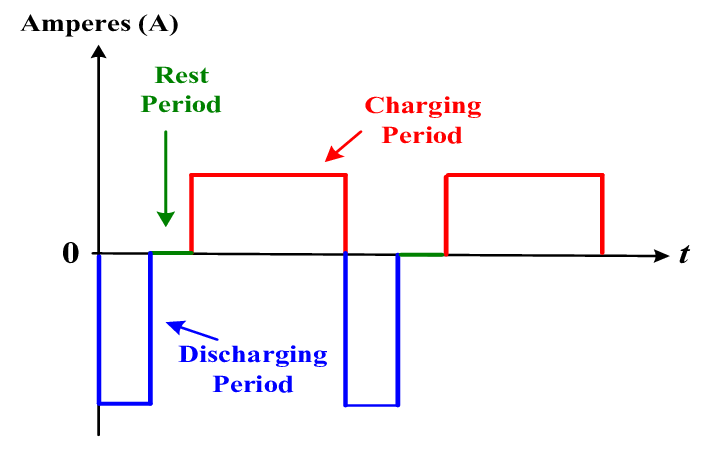
Figure 10: Burp Charging Diagram
How Burp Charging Works?
Here's how it works and why it's beneficial:
When charging, these batteries can form gas bubbles on their electrodes, blocking the flow of electricity. Burp charging involves short discharges, or "burps," that help pop these bubbles, keeping the electricity flowing smoothly.
The brief discharges help keep the internal environment of the battery stable. Reducing gas buildup and internal pressure, burp charging ensures a more even distribution of charge within the battery.
Burp charging reduces the risk of overcharging and overheating, common problems with traditional charging methods. This makes the charging process faster and ensures the battery charges fully and evenly.
By preventing gas buildup and overheating, burp charging helps maintain the battery's internal components. This leads to a longer lifespan for the battery.
IUI Charging
IUI Charging is a modern method for fast charging standard flooded lead-acid batteries. It involves three phases: an initial constant current phase until a set voltage is reached, a constant voltage phase where current decreases until another preset level, and a final return to constant current. This approach ensures even charging across all cells, maximizing performance and lifespan.
The IUI charging method is beneficial for standard flooded lead-acid batteries because it ensures even charging across all cells, good for maintaining optimal performance and extending the overall lifespan of the battery. IUI charging controls current and voltage to prevent overcharging or undercharging, reducing the risk of battery failure. It also shortens charging time, making it efficient and practical for many uses.

Figure 11: IUI Charging Diagram
Float Charging
Float charging is a technique used mainly with lead-acid batteries in emergency power systems. This method involves connecting the battery and the load to a constant voltage source. The voltage is kept just below the battery's maximum capacity. This careful control of voltage prevents overcharging and ensures the battery is always ready for use.
Practically, float charging keeps the battery fully ready without the risk of overcharging. The constant voltage source offsets the battery's natural self-discharge, keeping its charge at an optimal level. This method is very useful for systems where the battery needs to be ready at any moment, like uninterruptible power supplies (UPS), emergency lighting, and standby generators.
Using float charging helps maintain the battery's reliability, making sure it can provide power when required. It also reduces the need for frequent maintenance and monitoring, making it a practical and efficient way to keep emergency power systems ready.
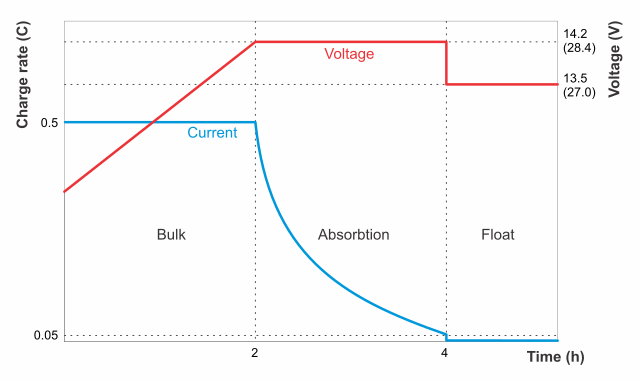
Figure 12: Float Charging Diagram
Random Charging
Random Charging is a method used when the power supply is unreliable or changes a lot. This often happens in situations like vehicles with changing engine speeds or solar panels affected by the weather.
In vehicles, engine speeds can vary a lot, causing irregular power outputs that make it hard for a battery to charge properly. Similarly, solar panels produce electricity based on sunlight, and can change quickly due to clouds or time of day. These changes can put a lot of stress on batteries if not handled right.
To deal with these issues, Random Charging uses special techniques to manage variable charging conditions. These include advanced algorithms and smart charging systems that adjust in real-time to power supply changes. With continuous monitoring the input power and adapting the charging process, these systems protect the battery from damage caused by fluctuating power.
Random Charging also ensures the battery works well and lasts longer, even with an inconsistent power source. It prevents overcharging during power surges and makes sure there's enough charging during drops in power.
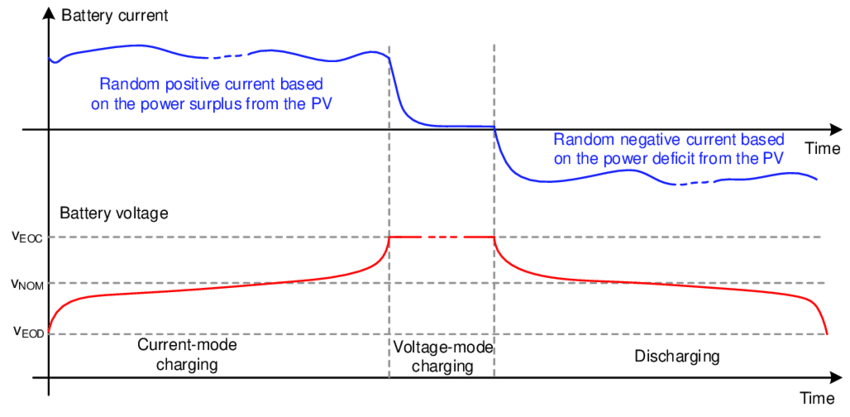
Figure 13: Graph for the Random Charging
Conclusion
Exploring different ways to charge batteries shows how important it is to improve battery technology to meet the growing needs of modern devices and systems. Basic methods like Constant Voltage and Constant Current, as well as more advanced techniques like Hybrid CVCC and Constant Power Charging, each have their own advantages and are best for specific types of batteries and uses. Progress in materials for electrodes, battery management systems, and the use of smart technology are important to making batteries work better and safer. The future of battery charging depends on developing and using these technologies to ensure they are sustainable, efficient, and reliable.
Frequently Asked Questions [FAQ]
1. What are the three main types of charging?
Slow Charging: This method uses standard AC (Alternating Current) power found in residential settings. Chargers operate at lower power levels (up to 3 kW), making it suitable for overnight charging.
Fast Charging: Fast chargers use higher levels of AC power (up to 22 kW) and are found in public charging stations. They can charge an electric vehicle (EV) battery faster than slow chargers, usually within a few hours.
Rapid Charging: These are the quickest chargers available, utilizing DC (Direct Current) power. They can power up most of an EV's battery capacity in under an hour. Power levels start from around 50 kW and can go up to 350 kW for the most advanced systems.
2. What are the different types of charges?
Per Minute Charging: This pricing structure charges users based on the amount of time connected to the charger, regardless of the amount of electricity consumed.
Per kWh Charging: This is a usage-based pricing model where users are billed based on the electricity consumed by their vehicle in kilowatt-hours. This method is considered fairer as it directly correlates to the energy used.
Flat Rate Charging: Some charging stations offer a flat rate for a specified charging window, such as an hour or a day, and can be beneficial for longer stops.
3. What is mode 1 and mode 2 charging?
Mode 1 Charging: This is the simplest form of EV charging, where the vehicle is connected directly to a standard household electrical outlet without any special equipment. It's slow and used for smaller vehicles or overnight home charging.
Mode 2 Charging: This mode also involves charging from a standard electrical outlet but includes a cable with a built-in protection device. This device safeguards against electric shocks and other potential electrical hazards, making it safer than Mode 1 and more versatile.
4. How to keep battery health at 100%?
Avoid Extreme Charging: Do not routinely charge the battery to 100% or let it drain to 0%. Keep the charge between 20% and 80%.
Control Temperature: Batteries operate best in moderate temperatures. Avoid exposing the battery to extreme cold or heat.
Use Manufacturer-Recommended Chargers: Always use the charging equipment recommended by the vehicle manufacturer to avoid damaging the battery.
Regular Use and Maintenance: Regular use and timely maintenance checks help in maintaining battery health. Long periods of inactivity can degrade battery performance.
5. What is the best setting to charge a battery?
Charging Speed: Fast charging is convenient but can stress the battery. Slow or moderate charging speeds are preferable for daily use to extend battery life.
Temperature Control: Charging in a controlled environment where the temperature is moderate helps preserve the battery's health and efficiency.
Charging Range: Keeping the battery's state of charge between 20% and 80% during regular use can impact its longevity and performance.